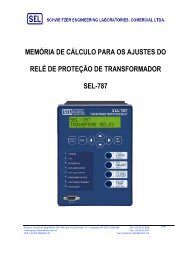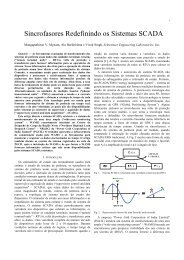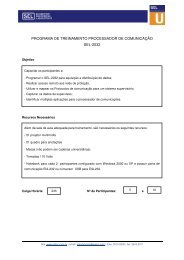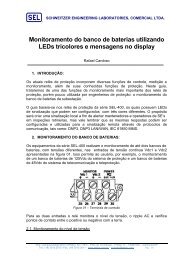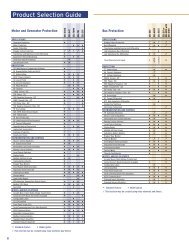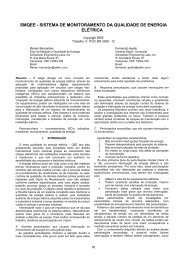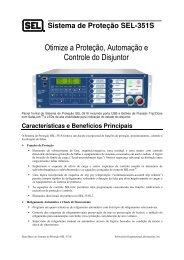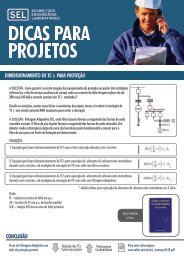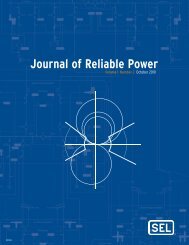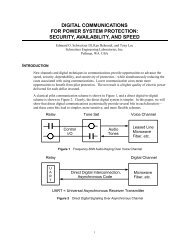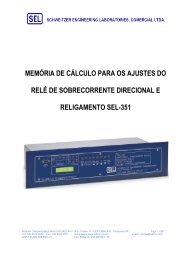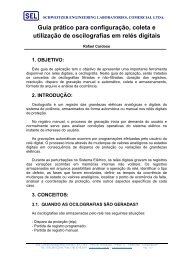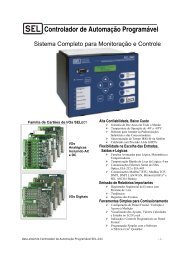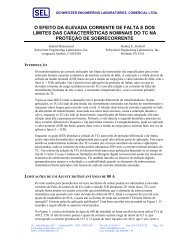Journal of Reliable Power - SEL
Journal of Reliable Power - SEL
Journal of Reliable Power - SEL
You also want an ePaper? Increase the reach of your titles
YUMPU automatically turns print PDFs into web optimized ePapers that Google loves.
Complete reclosing relay supervision requires three<br />
secondary arc extinction detectors, one per phase. These<br />
detectors measure the angle, φ, between the phase-to-ground<br />
voltage <strong>of</strong> the faulted phase (V γ ) and the sum <strong>of</strong> the sound<br />
phases phase-to-ground voltages (V Σ ). For -β ≤ φ ≤ β, and |V γ |<br />
> V thre , the detector determines the secondary arc extinction<br />
and asserts the SAED bit. β and V thre determine the region that<br />
detects the secondary arc extinction. Table 3 shows the V γ and<br />
V Σ voltages for A-, B-, and C-phase SAEDs.<br />
TABLE 3<br />
V γ AND V Σ VOLTAGES FOR A-PHASE, B-PHASE, AND C-PHASE SAEDS<br />
Detector V γ V Σ<br />
A-phase V A V B + V C<br />
C. SAED Performance in Transmission Lines With Shunt<br />
Compensation<br />
SAED is suitable for lines with or without shunt reactor<br />
compensation. We will look at the performance <strong>of</strong> the SAED<br />
for an A-phase-to-ground fault at the middle <strong>of</strong> the line in the<br />
power system shown in Figure 8. In this case, we assume that<br />
both breakers at the line ends open A phase poles to create an<br />
A-phase open condition. Figure 24 shows the A-phase voltage<br />
and the fault current through the arc at the fault location. The<br />
fault occurs at cycle eight (133 ms) and the poles open at<br />
cycle 14 (233 ms). The figure also illustrates the presence <strong>of</strong><br />
arc; primary arc exists before the breaker poles open, and<br />
secondary arc exists after the breakers clear the fault. The<br />
secondary arc extinguishes at cycle 23.5 (392 ms).<br />
B-phase V B V C + V A<br />
C-phase V C V A + V B<br />
The angle φ = 180° and V γ is outside <strong>of</strong> the SAED region<br />
when the line is energized under normal conditions as shown<br />
in Figure 22.<br />
During single-pole open conditions, after the secondary arc<br />
extinguishes, the angle φ = 0° and V γ is inside the SAED<br />
region (Figure 23). The A-phase detector asserts the SAED bit<br />
for this condition, allowing the reclosing sequence to<br />
continue.<br />
V C<br />
φ<br />
β<br />
V Σ<br />
= V B<br />
+ V C<br />
V γ<br />
= V A<br />
β<br />
V thre<br />
V B<br />
Figure 22 The Angle φ = 180° and V γ is Outside <strong>of</strong> the SAED Region for<br />
Normal Conditions<br />
V C<br />
V γ<br />
= V A<br />
V Σ<br />
= V B<br />
+ V C<br />
Figure 23 V γ is Inside the SAED Region After the Arc Extinguishes<br />
V B<br />
Figure 24 A-Phase Voltage, Arc Current, and Arc Presence Indication for an<br />
A-Phase-to-Ground Fault at the Middle <strong>of</strong> the Line<br />
The A-phase voltage undergoes three significant changes<br />
during fault and pole-open conditions:<br />
• Voltage reduction because <strong>of</strong> the fault presence. The<br />
voltage changes from normal to fault conditions.<br />
• Additional voltage reduction after the breakers clear<br />
the fault. Reduced voltage exists during the pole-open<br />
condition while the secondary arc is present.<br />
• Voltage increase during the pole-open condition. The<br />
voltage increases after the secondary arc extinguishes.<br />
Figure 25 shows the A-phase voltage changes in magnitude<br />
and angle, and the SAED boundaries. During the pole-open<br />
condition before extinction <strong>of</strong> the secondary arc, the voltage<br />
magnitude is less than the voltage threshold, V thre , and the<br />
voltage angle is outside the 2β angle limits. After the<br />
secondary arc extinguishes, the voltage magnitude exceeds the<br />
voltage threshold, V thre , and the voltage angle is within the 2β<br />
angle limits <strong>of</strong> the SAED characteristic. You can see the A-<br />
phase voltage better in the polar plot <strong>of</strong> Figure 26. V A = 1∠0°<br />
(in per unit) before the fault occurs; V A = 0.7∠0° during the<br />
fault condition; V A = 0.1∠254° while the secondary arc is<br />
present; and V A = 0.8∠191° after the secondary arc<br />
extinguishes. The A-phase voltage operating point enters the<br />
A-phase SAED region after the secondary arc extinguishes.<br />
Transmission Line Protection System for Increasing <strong>Power</strong> System Requirements | 49



